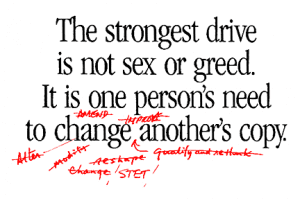 Copyediting services encompass many different types of editorial and proofreading services. A simple search on the Internet will reveal a wide variety of editing and proofreading services, and it appears that there is no universally accepted definition of the editing processes available. However, if you are considering hiring the services of a professional proofreader or editor, there are three general types of editing that you need to be aware of when determining which copyediting services will be the most suitable for your manuscript needs. Here’s an overview of the types of editing you may come across.
Copyediting services encompass many different types of editorial and proofreading services. A simple search on the Internet will reveal a wide variety of editing and proofreading services, and it appears that there is no universally accepted definition of the editing processes available. However, if you are considering hiring the services of a professional proofreader or editor, there are three general types of editing that you need to be aware of when determining which copyediting services will be the most suitable for your manuscript needs. Here’s an overview of the types of editing you may come across.
Proofreading
Proofreading is the most basic form of copyediting service, and the majority of professional editors will offer this at a lower price than their other editing services. A proofreader’s main role is to meticulously read through your document and ensure that it doesn’t contain any spelling, grammatical or consistency errors. As a rule, proofreaders will not rearrange the sentence structure, or reorder any problematic paragraphs. Proofreading is suitable for you if you are confident in your English language ability and feel that you do not require any assistance with the sentence structure or content of the manuscript or document. Using a proofreader is extremely important because, despite your best efforts, it is very difficult to thoroughly check a document for errors yourself. Expert proofreaders will go through each and every word and ensure that your text is perfect.
Line Editing
Line editing is one step up from proofreading. When line editing, proofreaders will conduct a more detailed review of your document and will literally go through the manuscript line by line. A good proofreader will read a manuscript several times when they are engaged in the line editing process, and they will meticulously check that the document is consistent, that there are no plot discrepancies and that it contains accurate spelling and grammar. Line editors use a very specific markup process when line editing and many line editors will use a series of codes, or proofreading symbols, to denote the changes to the text that are required.
In addition to checking basic spelling and grammar, line editing also involves editing for style and consistency. Some types of documents, such as legal manuscripts, dissertations, educational publications, etc. will need to follow certain writing conventions. In these cases, editors will consult a style guide to ensure that the conventions are followed accurately and that citations, quotations, and footnotes are properly formatted. Once line editors have reviewed a manuscript a couple of times, they will quite often revisit it to examine the formatting. This part of the process will be especially important if different editors and proofreaders have been used during the process. Some editors may also go one step further when providing copyediting services and will double-check that the facts presented in certain parts of the document are correct and up to date. For more information, see our guide to how to be a good editor.
Substantive Editing
The final type of copyediting services editors offer is substantive editing, which is even more detailed than line editing. Substantive editing is also known as developmental editing or comprehensive editing and—depending on the quality of the written material—can involve much more work on behalf of the editor. Substantive editing will often involve the editor restructuring, rewriting or paraphrasing elements of the manuscript. They will look at the document as a holistic piece and will ensure that it is coherent throughout and fits together as it should. They will add information, where necessary, and will delete anything that they feel is unsuitable or detracts from the message of the document. During the substantive editing process, the editor may work closely with the writer to discuss issues with the document and to negotiate a new structure or format. In some extreme cases, they may rewrite the entire document.
Online Copyediting Services
Vappingo offers both editing and proofreading services. In the case of editing, we recognize that there is a considerable overlap between substantive editing and line editing and, for this reason, we operate a model that is a combination of both processes. Our editors will generally start the editing process with a substantive pass through the entire manuscript. They will check the overall structure of the document, correct any immediately obvious sentence issues and ensure that the manuscript flows logically. They will then revisit the editing process and, on the second pass, will perform further copyediting while ensuring that references, citations, and quotations are correct. Finally, they will proofread the document in order to identify any mistakes they have missed through pass one and two.
Here at Vappingo we do not use a special markup language on a customer’s manuscript or dissertation unless they specifically request it. Instead, we mark the changes we have made by activating the Track Changes tool in Word. We then send our customers two versions of their document: a version that includes all the changes and editor comments, and a version in the final form, with all such changes accepted.

1 thought on “Copyediting Services Explained: This is What the Professionals Do”
Comments are closed.